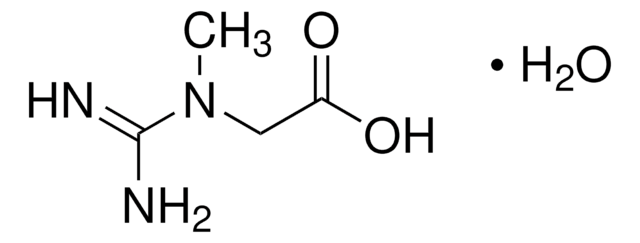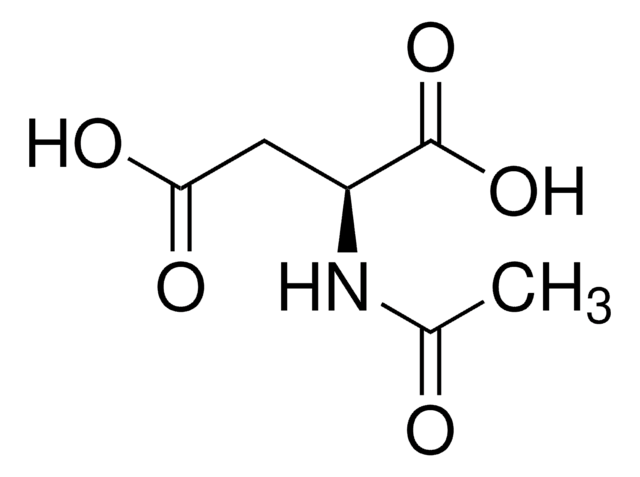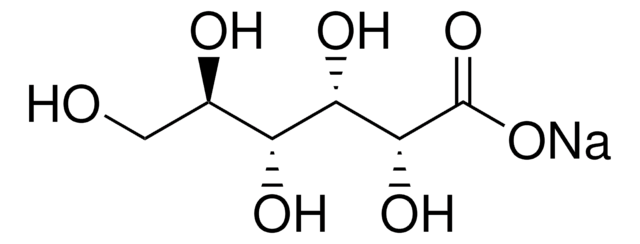おすすめの製品
詳細
Aspartic acid (or aspartate) is a non-essential amino acid, which means that it is naturally synthesized by mammals. Aspartate presents many biochemical roles:
In the L-conformation, aspartic acid is a building block in the production of proteins, as well as aiding in many bodily functions, including the urea cycle, gluconeogenesis, and Krebs Cycle, a process that generates adenosine triphosphate (ATP). Aspartic acid also works as a neurotransmitter. The D-Aspartate conformation is linked to neurogenesis and endocrine systems.
In the L-conformation, aspartic acid is a building block in the production of proteins, as well as aiding in many bodily functions, including the urea cycle, gluconeogenesis, and Krebs Cycle, a process that generates adenosine triphosphate (ATP). Aspartic acid also works as a neurotransmitter. The D-Aspartate conformation is linked to neurogenesis and endocrine systems.
アプリケーション
The Aspartate Metabolite Library is a kit that contains a selection of 23 metabolite involved in Aspartate metabolism.These may be used for general research, as reagents or as reference compounds in analytical procedures.
生物化学的/生理学的作用
Aspartate roles and metabolites:
- Aspartate is synthesized by transamination of oxaloacetate through the actions of Aspartate aminotransferase and pyridoxal 5′- phosphate. Aspartyl-tRNA synthase can then couple the aspartate to aspartyl tRNA for protein synthesis.
- Aspartate carries the reducing equivalents in the mitochondrial Malate-Aspartate shuttle, which uses the ready interconversion of aspartate and oxaloacetate.
- N-acetylaspartate synthase, present in the cytoplasm, converts aspartate to N-acetylaspartate, a brain metabolite that regulates dopamine.
- Asparagine is biosynthesized by Asparagine synthetase from aspartate, glutamine, and ATP. Asparagine is involved in the metabolic control of cell functions in nerve and brain tissue.
- Arginosuccinic acid is synthesized from aspartate, citrulline and ATP through the action of Argininosuccinate synthase, one of the enzymes of the urea cycle. In this metabolic pathway, neurotoxic ammonia, produced by protein catabolism, is converted into urea in the liver.
- Fumaric acid is synthesized from Argininosuccinic acid via an Argininosuccinate lyase, which is an enzyme in the Citric Acid Cycle.
- Inosinic acid, aspartic acid and GTP are interconverted to GDP and AMP by the Adenylosuccinate synthetase isozyme 1. This process is involved in the purine nucleotide cycle which regulates nucleotides levels in various tissues.
- Aspartate transcarbamoylase catalyzes the synthesis of N-carbamoyl-L-aspartate from carbamoyl phosphate and aspartate that are involved in the de novo biosynthesis of pyrimidines.
- Beta alanine is formed by decarboxylation of aspartate by Glutamate decarboxylase 1 in the cytoplasm.
- L-aspartate is converted to D-aspartate through the action of a D-aspartate racemase. D-aspartate contributes to the synthesis and release of glucocorticoids, prolactin, oxytocin, and steroids. D-aspartate plays an important role in the brain activity of mammals.
構成
Contains 10 mg each of Aspartate metabolism metabolite standards packaged individually.
キットの構成要素は別途購入可能です。
製品番号
詳細
SDS
- A2252Adenosine 5′-monophosphate monohydrate, from yeast, ≥97%SDS
- A2383Adenosine 5′-triphosphate disodium salt hydrate, Grade I, ≥99%, from microbialSDS
- A5707Argininosuccinic acid disodium salt hydrate, ≥80%SDS
- 146064β-Alanine, 99%SDS
- C4135Carbamyl phosphate disodium salt, ≥80%SDS
- C7629L-Citrulline, ≥98% (TLC)SDS
- 219096D-Aspartic acid, ReagentPlus®, 99%SDS
- F6625Flavin adenine dinucleotide disodium salt hydrate, ≥95% (HPLC), powderSDS
- 47910Fumaric acid, ≥99.0% (T)SDS
- G7252Guanosine 5′-diphosphate tris salt from Saccharomyces cerevisiae, Type VI, ≥92.5%SDS
- G9002Guanosine 5′-triphosphate tris salt, ≥93% (HPLC), powderSDS
- I2879Inosine 5′-monophosphate from Saccharomyces cerevisiae, ≥98%SDS
- A5006L-Arginine, reagent grade, ≥98%SDS
- A0884L-Asparagine, ≥98% (HPLC)SDS
- 11189L-Aspartic acid, BioUltra, ≥99.5% (T)SDS
- G1251L-Glutamic acid, ReagentPlus®, ≥99% (HPLC)SDS
- G3126L-Glutamine, ReagentPlus®, ≥99% (HPLC)SDS
- 00920N-Acetyl-L-aspartic acid, ≥99.0% (T)SDS
- O4126Oxaloacetic acid, ≥97% (HPLC)SDS
- K1750α-Ketoglutaric acid, ≥98.5% (NaOH, titration)SDS
- P9255Pyridoxal 5′-phosphate hydrate, ≥98%SDS
- P8010Sodium pyrophosphate tetrabasic, ≥95%SDS
- 69037Ureidosuccinic acid, 98.0-102.0% (T)SDS
すべて表示 (23)
シグナルワード
Danger
危険有害性情報
危険有害性の分類
Acute Tox. 4 Oral - Eye Dam. 1
保管分類コード
11 - Combustible Solids
適用法令
試験研究用途を考慮した関連法令を主に挙げております。化学物質以外については、一部の情報のみ提供しています。 製品を安全かつ合法的に使用することは、使用者の義務です。最新情報により修正される場合があります。WEBの反映には時間を要することがあるため、適宜SDSをご参照ください。
毒物及び劇物取締法
キットコンポーネントの情報を参照してください
PRTR
キットコンポーネントの情報を参照してください
消防法
キットコンポーネントの情報を参照してください
労働安全衛生法名称等を表示すべき危険物及び有害物
キットコンポーネントの情報を参照してください
労働安全衛生法名称等を通知すべき危険物及び有害物
キットコンポーネントの情報を参照してください
カルタヘナ法
キットコンポーネントの情報を参照してください
Jan Code
キットコンポーネントの情報を参照してください
試験成績書(COA)
製品のロット番号・バッチ番号を入力して、試験成績書(COA) を検索できます。ロット番号・バッチ番号は、製品ラベルに「Lot」または「Batch」に続いて記載されています。
Pyrimidine Biosynthesis
Lennarz W J, et al.
Encyclopedia of Biological Chemistry, 600-605 (2004)
ライフサイエンス、有機合成、材料科学、クロマトグラフィー、分析など、あらゆる分野の研究に経験のあるメンバーがおります。.
製品に関するお問い合わせはこちら(テクニカルサービス)









